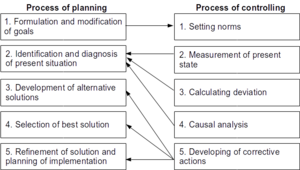Planning
Planning is a process of setting aims and adequate actions in order to reach the aim. It means that the managers think about their aims and actions in advance and that the actions are supported by corresponding methods, plans or logic, not based on feelings or intuition.
Planning is the primary stage of the management process, involves the determination of the purpose and direction of the organization. Defines what to do, when and how this should be done and who should do it. Planning is the process: the plan must be realized, and during its implementation it may be necessary to modify it.
Plans designate main goal of the organization and define the best realization procedures. Moreover, the plans are the guidelines by which:
- Organization obtains and assigns resources needed to reach the goals.
- Members of organization work according to chosen goals and procedures.
- The progress is verified and measured, so that the corrective actions are taken if needed.
Types of planning
- Strategic (more than 5 years) – future plan, which helps setting the right actions and way of accomplishment
- Long term (2–5 years) – specific ventures aimed to reach the fundamental goal
- Midterm (few months – one year) – a statement, what needs to be done to accomplish the long term plan
- Short term (max 3 months) – short, urgent tasks
- Current – plans that need to be done daily or weekly, concerning everyday plans
Steps of planning
- The first step is always choosing a goal (define objectives) for the organization. Firstly, there is always done an analysis of the reality where the company exists. The environment, its strengths and weaknesses, executive's ambition and the potential ready to be engaged in the process of implementation of the new strategy have a great impact on every further step of planning.
- Next, the aims for each unit, its branches or departments, are defined.
- Before proceeding to final step in planning, detailed SWOT analysis should be performed, to determine strengths and weaknesses of the organization,
- After setting a goal the company sets the program and the plan for its systematic realization. While choosing a certain aim and elaborating its program the head of the venture need to consider if it is possible to reach the goal with the chosen program, and if it is acceptable for other managers and employees.
Relationships between planning and control
Control is the process for ensuring that the activities are consistent with the plans, control is impossible without a plan (fig. 1.). Control is based on a comparison of the facts on the events and processes, with their pre-planned levels. Control may lead to adaptation of plan.
See also:
- Management functions
- Departmental planning
- Implementation and control of marketing plan
- Types of planning
References
- Ansoff, H. I., & McDonnell, E. J. (1990). Implanting strategic management (Vol. 2). New York: Prentice Hall.
- Pearce, J. A., Robinson, R. B., & Subramanian, R. (2000). Strategic management: Formulation, implementation, and control. Columbus, OH: Irwin/McGraw-Hill.
- Thompson, J. L. (2001). Strategic management. Thompson Learning.
Author: Agnieszka Paszek
